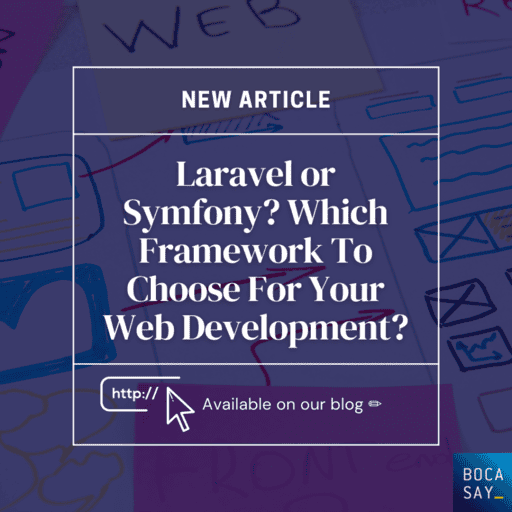Laravel vs. Symfony
Software development frameworks are pre-established structures, or sets of practices, that are designed to help software developers build robust software applications more efficiently.
Providing a standard approach to developing software, frameworks offer a set of guidelines, best practices and reusable code libraries that facilitate the development process.
More specifically, frameworks typically include a variety of tools and libraries that software developers can use to streamline the development process. These tools may include pre-built components, automated testing frameworks, integrated development environments (IDEs) and other resources that help developers write code more quickly and accurately.
In this article, Bocasay, our offshore outsourcing company, provides an introduction to the benefits of the Laravel and Symfony frameworks.

What is the Laravel Framework?
Laravel is a free, open-source PHP web application framework that was created by Taylor Otwell in 2011. It is a popular framework that provides a robust set of tools and features for building modern, scalable web applications. Laravel follows the Model-View-Controller (MVC) architectural pattern, which helps developers to organize their code and separate concerns between the different components of their application.
The framework is known for its expressive and elegant syntax, which makes it easy to write and read code. Overall, Laravel is a powerful and flexible framework that can be used to build a wide range of web applications, from small personal blogs to large enterprise-level applications.
Laravel Key Features:
Routing: Laravel provides a simple, expressive syntax for defining application routes. Developers can easily define RESTful routes for their applications, making it easier to build APIs and web applications.
ORM: Laravel’s eloquent ORM (Object-Relational Mapping) is a powerful and easy-to-use database query builder that enables developers to work with databases by using intuitive syntax.
Blade Templating Engine: The Blade Templating Engine provides a simple yet powerful way to create HTML templates for your application. It provides a clean, readable syntax that makes it easy to create and maintain templates.
Middleware: The middleware system provides a flexible way to add additional functionality to your application’s HTTP requests. This allows developers to easily add features such as authentication, caching and rate limiting.
Artisan CLI: Artisan is Laravel’s built-in command-line interface (CLI) tool. It provides a wide range of commands for performing common development tasks, such as database migrations, testing and generating boilerplate code.
MVC Architecture: Laravel follows the Model-View-Controller (MVC) architectural pattern, which helps to separate concerns between the different components of an application, making it easier to maintain and update.
Testing: Laravel includes built-in support for testing your applications. It provides a range of testing tools and helpers, including PHP Unit integration, HTTP testing, and database testing.
𝔻𝕠 𝕪𝕠𝕦 𝕙𝕒𝕧𝕖 𝕒 𝕨𝕖𝕓 𝕡𝕣𝕠𝕛𝕖𝕔𝕥 𝕚𝕟 𝕟𝕖𝕖𝕕 𝕠𝕗 𝕕𝕖𝕧𝕖𝕝𝕠𝕡𝕞𝕖𝕟𝕥? 𝔸𝕥 𝔹𝕠𝕔𝕒𝕤𝕒𝕪, 𝕪𝕠𝕦𝕣 𝕠𝕗𝕗𝕤𝕙𝕠𝕣𝕖 𝕠𝕦𝕥𝕤𝕠𝕦𝕣𝕔𝕚𝕟𝕘 𝕔𝕠𝕞𝕡𝕒𝕟𝕪, 𝕠𝕦𝕣 𝕕𝕖𝕕𝕚𝕔𝕒𝕥𝕖𝕕 𝕥𝕖𝕒𝕞𝕤 𝕠𝕗 𝕕𝕖𝕧𝕖𝕝𝕠𝕡𝕖𝕣𝕤 𝕡𝕣𝕠𝕧𝕚𝕕𝕖 𝕨𝕖𝕓 𝕒𝕡𝕡𝕝𝕚𝕔𝕒𝕥𝕚𝕠𝕟 𝕤𝕠𝕝𝕦𝕥𝕚𝕠𝕟𝕤 𝕗𝕠𝕣 𝕝𝕖𝕒𝕕𝕚𝕟𝕘 𝕔𝕠𝕞𝕡𝕒𝕟𝕚𝕖𝕤 𝕒𝕣𝕠𝕦𝕟𝕕 𝕥𝕙𝕖 𝕨𝕠𝕣𝕝𝕕. 𝔾𝕖𝕥 𝕚𝕟 𝕥𝕠𝕦𝕔𝕙 𝕥𝕠 𝕗𝕚𝕟𝕕 𝕠𝕦𝕥 𝕙𝕠𝕨 𝕨𝕖 𝕔𝕒𝕟 𝕙𝕖𝕝𝕡 𝕪𝕠𝕦𝕣 𝕟𝕖𝕩𝕥 𝕡𝕣𝕠𝕛𝕖𝕔𝕥.
What is the Symfony Framework?
Symfony is a dynamic, open-source PHP framework with MVC architecture. It was first published by SensioLabs as free software in 2005, and subsequently released under the MIT License.
It is one of the most popular application frameworks among the open-source developers’ community. Widely-known for great performance, agility and well-tested MVC architecture, Symfony is a robust framework that works fast and can support key business tasks. Last but not least: With cutting-edge configuration, Symfony can minimize the chances of code errors, increase productivity and benefit companies with a series of readily-available software components.
Symfony Key Features
Bundles: Symfony uses a modular system called Bundles. This enables developers to easily add and remove functionality to their applications. Bundles are reusable, standalone packages of code that can be shared across different Symfony projects.
Dependency Injection: Symfony’s dependency injection system allows developers to define their application’s dependencies in a centralized configuration file. This makes it easy to manage and modify dependencies throughout the application.
Routing: Symfony provides a powerful routing component that allows developers to easily define and manage application routes. This component supports advanced features such as route parameters, optional parameters and regular expression patterns.
Templates: Powered by a flexible templating system, Symfony provides a variety of templating languages, including Twig and PHP. This makes it easy to create and maintain HTML templates for your application.
Doctrine ORM: Symfony integrates with the Doctrine ORM (Object-Relational Mapping) system, which provides a powerful and flexible way to work with databases. Doctrine supports a wide range of databases, including MySQL, PostgreSQL, and Oracle.
Security: Symfony provides a comprehensive security system that includes features such as authentication, authorization, and encryption. This makes it easy to secure your application and protect user data.
Testing: Symfony includes built-in support for testing your applications. It provides a range of testing tools and helpers, including PHPUnit integration, HTTP testing and browser testing.

Comparing Laravel and Symfony
Laravel and Symfony are both popular PHP frameworks that offer a range of features for building web applications. Here are some differences between the two frameworks:
Architecture: Laravel and Symfony have different architectural approaches. Laravel is built around the MVC (Model-View-Controller) architecture, which provides a clear separation of concerns between the application’s components. Symfony, on the other hand, uses a modular architecture based on reusable components called “bundles.”
Ease of Use: Laravel is often considered to be easier to use than Symfony, thanks to its intuitive syntax and clear documentation. Laravel also includes a number of built-in features, such as authentication and database management, that make it easier to get started with.
Flexibility: Symfony is often considered to be more flexible than Laravel, thanks to its modular architecture and the ability to use only the components that are needed for a particular project. This can make it easier to build complex, large-scale applications.
Performance: Symfony is generally considered to be faster and more performant than Laravel, especially when it comes to handling large-scale applications with many components and dependencies.
Learning Curve: Symfony has a steeper learning curve than Laravel, due to its more complex architecture and the need to understand how bundles work. However, Symfony’s documentation is very comprehensive and provides a clear path for learning the framework.
Ultimately, the choice between Laravel and Symfony will depend on the specific needs of your project and the skills of your development team. Both frameworks are powerful and flexible, and can be used to build a wide range of web applications.